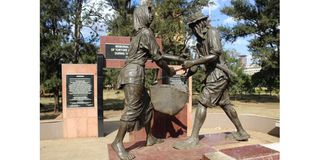
Mau Mau monument that stands at Freedom Corner in Uhuru Park, Nairobi in honour of Mau Mau war victims.
What you need to know:
Last week there was an installation of Mau Mau era detention camps at the Baraza Media Lab. It is the work of the Museum of British Colonialism (MBC), a collective of volunteers in Kenya and Europe, whose mission is “to restore and make visible suppressed, destroyed or underrepresented histories relating to British colonialism”.
In the house, the announcement said, would be Ms Chao Tayiana of MBC to speak about the project. I had earlier in the year read a wire story about the work MBC was doing to create a digital museum of the Mau Mau story, and been fascinated.
The announcement also gave us some “jaribu” (a taste) of a part of the 3D miniature model of a detention camp.
To borrow the phrase “you had me at hello” made popular by the 1996 film “Jerry Maguire”, it had me at 3D miniature model.
So, on the Friday evening, fully masked and sanitised, we rocked up at Baraza Media Lab for the show. If you’ve read many books and stories on the Mau Mau uprising, and seen your fair share of documentaries on it, there is a part of you that wonders if there’s still much left to know.
As an outsider, I very quickly found that there was. There were several jarring elements of the installation and moments in Tayiana’s presentation, and will not spoil for those who will go to future exhibitions, but two did it for me.
Detention centres
The Mau Mau uprising was largely confined to central Kenya, as was, it seemed, the colonial government’s counter-insurgency. There were several Kenyans from other areas who joined it, as did a few East Africans.
What most literature doesn’t describe much, is how spread the infrastructure for quelling the uprising was.
The installation had a dramatic map showing where the various centres Mau Mau detainees were held were. They were dozens of them littered all over Kenya, and as Tayiana explained, many towns in the country today grew out of those detention centres. Prisoners were categorised in black, grey, and white categories.
The black ones were the tough guys, and held the furthest away from central Kenya. The ones that begun to “reform” and cooperate with the colonial state to tell on the Mau Mau, entered the grey zone, and were brought nearer home. The ones that turned and renounced the Mau Mau were white, and brought home, say to a camp in Nyeri.
It was telling just how much the colonialists weaponised geography, and proximity to relatives, against the Mau Mau.
The second moment came when Tayiana was speaking about and showing detainee camps that were repurposed. Mweru Work Camp is present day Mweru High School.
We also know that Aguthi Works Camp solitary camp is now Kangubiri Girls High School. The devil though was in the detail; it had barbed wire along the roof lining of the cells – and the barbed wire is still there today, as part of the school building security!
You could see Tayiana’s killer punch coming from a kilometre away. The Mau Mau, she said, is the only organisation in Africa, if not the world, that was part of a country’s liberation that was outlawed at independence, and remained so until 40 years later in 2003.
Modern-day Kenyan education doesn’t teach the uncomfortable details of the Mau Mau uprising, as part of a wider approach in which Kenyan students never learn the empowering aspects of their history.
Referencing the barbed wire, she argued that they symbolise the mental prison that Kenya’s – and one could add many of Africa’s – classrooms still are.
Colonial era cannon
It gets you thinking about what else. For starters, there are the colonial governor’s mansions all over Africa that became our post-independence dictators’ state houses.
In many parts of the continent, several colonial era prisons still serve the same purpose. The same brand of justice is being administered in the colonial courts where we run our judicial business today.
One of the most ubiquitous, and odd ones, is the colonial era cannon. Many African towns have the carcass of the large-calibre gun proudly displayed in their square, as a tourist attraction, oblivious to the fact that it was the weapon that tilted the balance of power against the “natives” in favour of the colonial powers.
That said, it is not Aguthi Works Camp solitary camp should not survive as Kangubiri Girls High School, or that the cannons shouldn’t be in town gardens. Rather, it is how they should exist. They should be subverted and reimagined.
As the controversial but supremely talented Congolese musician Pamba Wemba, one of the godfathers of the dandy “sapeurs” dressers said, they took western clothes and built a different and very stylish tradition out of them.
The cannons could be melted or reconstructed in monuments commemorating independence heroes. Kangubiri Girls? Give it the Pamba Wemba treatment. Go bigger. Turn into a chamber of horrors that shocks people about the terrors of the chambers where the Mau Mau were tortured.
The author is a journalist, writer, and curator of the “Wall of Great Africans”. Twitter@cobbo3





No comments :
Post a Comment